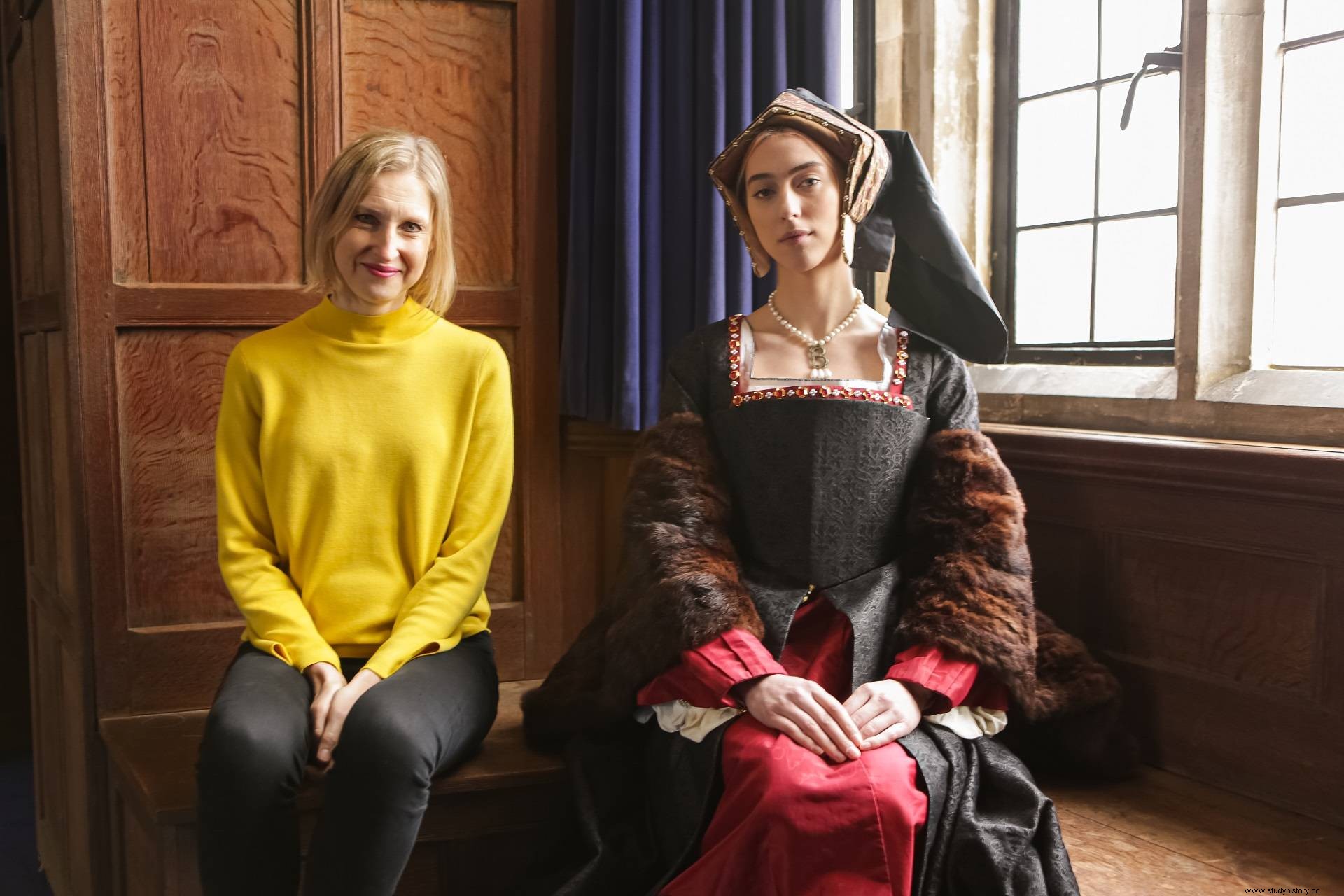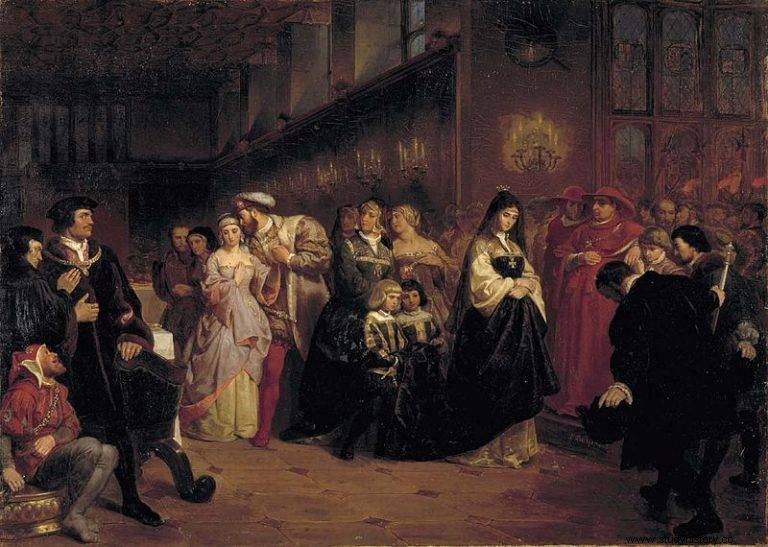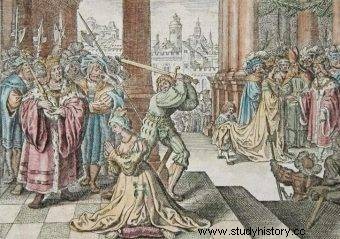Anna Boleyn. The first queen to be sentenced to death in England, one of Henry VIII's many women and ringleader of the religious revolution. Was she a ruler adored by her subjects, or on the contrary - a widely hated witch?
Anna found herself at the royal court in 1522. She was quickly noticed by Henry VIII, who, blinded by his feelings for the young woman, decided to annul his marriage to Catherine of Aragon (which was not an easy undertaking). Anna turned the king's mind, the king stubbornly strove for her charms, until finally their paths joined - they became married. Unfortunately, their "happy lives" turned out, well, not very long ...
Anna and her family
Anna Boleyn was the daughter of Count Thomas Boleyn, a respected diplomat working closely with Henry VIII, and Elizabeth Howard - Queen Catherine of Aragon (the first wife of the King of England). She was born in 1501 or 1507; we do not know the exact date.
Tomasz and Elżbieta had five children, but two died in childhood. Anna, Jerzy, and Maria spent their joyful childhood at the Hever Court in Kent. The property belonged to the Boleyn family. Anna was a bright and intelligent girl, educated in accordance with her social class - she learned reading and writing, counting and history with the complete genealogy of her own family. In addition, the "core curriculum" included household and entourage management, sewing, dancing, music education and learning good manners that were to be useful to the young noblewoman in the future.
Until 1522, Anna and her sister spent their free time at French and Dutch courts, where they learned about court life, language and the culture prevailing on the continent. Anna officially appeared at the English court in March 1522 on the occasion of a reception organized for the ambassadors. At that time, she was considered a woman who knows fashion and knows the world, thanks to which she enjoyed considerable recognition and respect.
Interestingly, her sister - Maria - had arrived in England three years earlier, and although she had married noble William Carey, she quickly became a royal mistress.
Royal love
In 1526, Henry VIII proposed to Anna the title of maitresse en titre denoting the main royal mistress. Anna, however, did not accept this "generous" offer. After all, she wanted to be a royal wife, not a mistress.
Henry VIII could not wait for the rightful heir to the throne. He wanted a male heir. He wanted to ensure the durability of the dynasty and to do everything to prevent a civil war. Unfortunately m his marriage with Katarzyna Aragońska did not bring him his dream son. The Queen gave birth to only one healthy child - a daughter, although she was pregnant six times.

Historian Tracy Borman examines the last days of Anna Boleyn's life - the day of her arrest, the day of her trial, and the day of her execution.
So when Henry met Anna, he decided to try his luck by her side. Before that, however, he had to get rid of his predecessor. Murder or divorce was out of the question. So the ruler began to try to annul the relationship. The crowning argument in the trial was the fact that Catherine's marriage was cursed because the queen was the widow of his brother Arthur. For this reason, in order for it to be concluded at all, a dispensation from the pope was needed. Therefore, to annul them, this dispensation had to be skillfully challenged!
Soon most of the courtiers guessed that Anna was the new chosen one of the king, although Henry VIII himself wanted to keep it a secret for as long as possible. As early as 1527 she settled permanently at the court and was able to enjoy all the privileges reserved exclusively for the queen.
New Religion
Meanwhile, Henry sent his secretary to Rome to ask the Pope directly for annulment of the marriage and permission to marry any other woman (regardless of origin!). Clement VII did not agree to this. Later attempts by Cardinal Thomas Wolsey (English politician and clergyman) also failed.
Finally, Clement VII decided that in this case a special ecclesiastical court would decide the decision (one of the legates was to be the cardinal mentioned earlier) . However, the court could not reach an unequivocal judgment, so the Pope forbade Henry VIII to marry any woman. Anna and trusted courtiers convinced the king that Wolsey was behind this decision. They obviously just wanted to get rid of the cardinal. And we did it! Wolsey was accused of treason in 1530, but he did not live to see the punishment - he died on the way to prison.
Ultimately, the king, at the instigation of Thomas Cranmer - a priest of the Boleyn family, a reformer and archbishop of Canterbury - decided that the pope could decide various issues of canon law, but the matter of his marriage to Catherine of Aragonese was biblically based and its annulment should be approved by university biblical scholars.

Anna was not the first wife Henry VIII got rid of. However, Katarzyna Aragońska was more fortunate - she was not sentenced to death.
Thomas Cromwell also added justification to withdraw from Rome, announcing two laws recognizing Henry VIII as the head of the Church in England. Cranmer was made archbishop, while Cromwell was appointed chancellor. Under such favorable conditions, Henry was able to marry Anna. In 1531 Catherine of Aragon left the court, and Miss Boleyn took over the royal chambers.
Wedding, coronation and problems with the Pope
In January 1533, Henry and Anna were secretly married in London. The previous marriage was officially annulled four months later - in May (the news about this event was announced by Tomasz Cranmer). Then the relationship of the king with the new bride became legal.
Shortly thereafter, on June 1, 1533, Anna officially became Queen of England. The coronation was to be very solemn. Henryk made efforts to ensure that his new wife had the support of the people and the court, but during the celebrations the great enthusiasm of his subjects was not evident. To mask this, after the ceremony, balls and parties were held outside for several days, and the new queen received a sizeable entourage of over 200 people.
However, the Pope did not give up. He still thought that Henry should return to Catherine. This one, however, announced the First Succession Act - a document making the English clergy independent of the papacy (the ruler of the country was the head of the Anglican Church).
Ups and downs
Meanwhile, Anna was getting ready for her first childbirth in specially prepared rooms Greenwich Palace. All courtiers, including the king, expected the birth of a male child. The Queen was aware of the pressure on her. On September 7, 1533, she gave birth to a child - Princess Elizabeth.
Henry could not hide his disappointment, and the atmosphere at court grew thicker with each passing day. A year later, the Queen was pregnant again, but had a miscarriage before Christmas 1534. These events started a series of conflicts in the marriage.

Anna Boleyn was beheaded for alleged betrayal
Embittered Henryk ostentatiously invited his mistress to his bedside, while Anna fell into depression and insane jealousy , she conspired against the new women she knew in her husband's life. Nevertheless, at the end of 1535, she became pregnant again.
In the meantime, information about the death of Catherine of Aragon reached the court. This news put Henryk and Anna in a happy mood, even on this occasion there were fun! The happy time did not last long, however, because Henry began flirting with Jane Seymour, one of the ladies of the court. After Anna found a pair of lovers, waiting for the birth of a child turned into a nightmare - the queen had a miscarriage, and the deceased child turned out to be a long-awaited boy . Anna knew very well that Henry's anger could endanger her life. So it happened…
Death of Anna Boleyn
Miscarriages and the lack of a dream son made Henryk furious more and more often. In addition, the new lover set the same condition as Anna - she dreamed of the role of the queen, not the main mistress. Henryk wanted to end the relationship with Anna as soon as possible. The easiest way was to get rid of the unwanted wife - literally.
The plot was carried out deliberately . Several men from Anna's entourage were selected and accused of being the Queen's lovers. Though they initially denied their innocence, some eventually confessed after cruel torture. Anna was also considered to be having sexual relations with her own brother!
In mid-May 1536, some of the accused took place, including Anna's brother, Jerzy. The Queen was charged with high treason, adultery and incest. On May 14, it was announced that Henryk's marriage to Anna was invalid, three days later Jerzy and other "culprits" were executed. The execution of Anna Boleyn took place on May 19, just before dawn.
